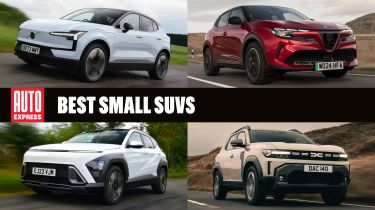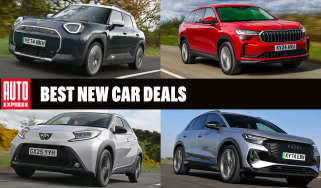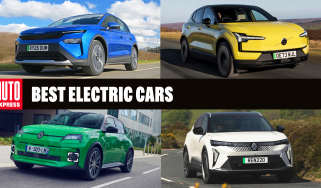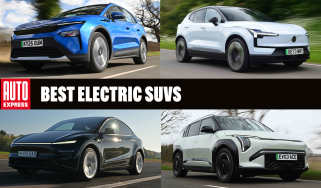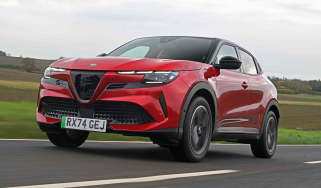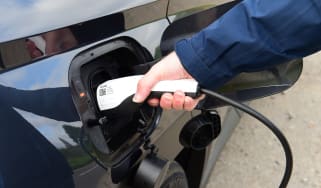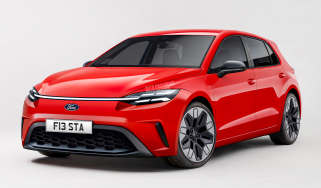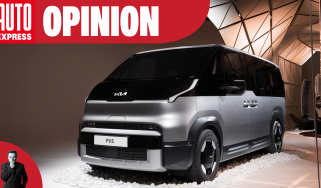Best small SUVs to buy 2025
There's a huge range of small SUVs out there, so we’ve picked out the very best
Thanks to their huge and growing popularity, there’s no shortage of small SUVs on the UK’s roads. The combination of small car running costs and big car practicality offered by these tough-looking runabouts suits plenty of buyers, which means just about every mainstream automotive manufacturer has tried its hand at being top dog in the class. The competition is fierce and the choice is wide but we’re here to help you find the very best small SUVs to buy right now.
Every small SUV on this top 10 best small SUVs list has been carefully tested and rated by our expert road testers and come out close to the head of the pack. Our small SUV testing regime is based on essential criteria for cars like this such as value for money, efficiency, equipment and urban driving performance.
There are a variety of fuel types to choose from, too, ranging from traditional petrol to fully electric power. The latter will be particularly tempting for company car users, thanks to low Benefit-in-Kind tax rates while private buyers who can charge at home can also slash their running costs.
If you’re still undecided as to which small SUV model you’d prefer after reading our list below, we also have a dedicated page that covers the best crossovers - conventional cars with a mild SUV flavour. Now let’s get started on the best small SUVs…
Compare the best small SUVs
You can see our individual review star ratings for the top 10 small SUVs in the table below, along with their starting price, fuel types and efficiency rating.
| Rank | Car | Prices from | Overall rating (out of 5) | Efficiency & running costs rating (out of 5) | Fuel |
| 1 | Dacia Duster | £19,380 | 4.5 | 4.4 | Mild-hybrid petrol or full-hybrid |
| 2 | Kia EV3 | £33,005 | 4.5 | 4.4 | Electric |
| 3 | MG ZS | £19,995 | 4 | 4 | Full-hybrid |
| 4 | Hyundai Kona | £26,735 | 5 | 4.5 | Petrol, hybrid or electric |
| 5 | Volvo EX30 | £33,060 | 4.5 | 4 | Electric |
| 6 | Alfa Romeo Junior | £28,100 | 4.5 | 4 | Hybrid or electric |
| 7 | Jeep Avenger | £25,219 | 4 | 4 | Mild-hybrid petrol or electric |
| 8 | Renault Captur | £22,195 | 4 | 4 | Petrol or full-hybrid |
| 9 | Kia Niro | £30,270 | 4 | 4.5 | Full-hybrid, PHEV or electric |
| 10 | Ford Puma | £26,580 | 4 | 4 | Petrol or electric |
Now scroll down for more details on each of our top rated small electric cars
1. Dacia Duster
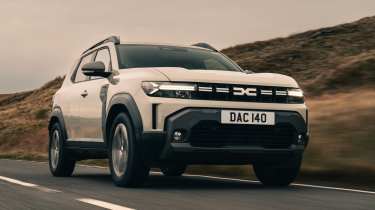
- Prices from £19,380
Pros |
Cons |
|
|
Just like its predecessor, the latest Dacia Duster follows the brand’s proven recipe of combining simplicity, capability and affordability.
You can pick up a brand-new Duster for under £20,000, and this really is a case of ‘more for less’ as the latest model is larger than its predecessor. The result is increased passenger space throughout and a substantial 517-litre boot.
Head- and legroom isn’t far off some mid-size SUVs from the class above, so there’s plenty of room to stretch out in the front and rear. If we really want to be fussy, some of the storage bins are a bit small and the ISOFIX points are located behind fiddly zips, but these minor drawbacks are forgiveable at this sort of price.
The level of space on offer makes the Duster a great choice as a budget-oriented family car, and you won’t need to panic about younger passengers making a mess of the trim or upholstery.
In order to keep costs down, simplicity and durability are the themes here rather than plushness. That being said, the cabin is still a bit fancier than the previous model’s, thanks to some angular designs and contrasting colours. Every Duster now features a digital driver’s display which is very simply laid out and easy to read, and all but the Essential trim models feature a 10.1-inch touchscreen infotainment display. While this isn’t exactly a groundbreaking system, we did find it easy to operate during testing.
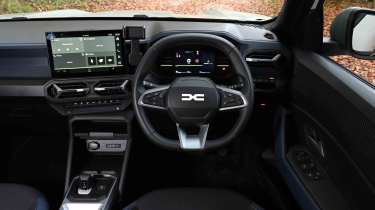
For those who enjoy venturing off-road, the Duster still comes with the option of four-wheel drive to back-up its chunky styling. Despite its off-roading capability, everything remains perfectly pleasant on tarmac, although we had hoped for just a little bit more in the driving fun department. As an affordable all-rounder, though, this really is a tough car to beat.
“The Duster isn’t the most refined or luxurious SUV for sale, but the car’s honesty makes it easy to enjoy, while the tough yet modern looks mean it can turn heads.” - Alex Ingram, chief reviewer, who tested the Duster in the UK.
Very few small SUVs manage to threaten the Dacia Duster when it comes down to price, but one model that does manage to fall shy of the £20,000 mark is the MG ZS. While the ZS looks far less muscular and off-road focussed than the Dacia, it does offer a similar level of practicality and standard features
2. Kia EV3
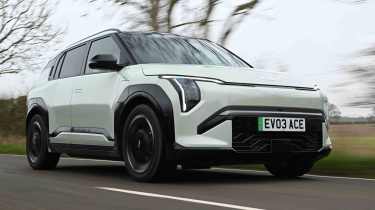
- Prices from £33,005
Pros |
Cons |
|
|
Just like its much larger EV9 cousin, the Kia EV3 offers distinctive styling, top tech and solid battery range.
Contrary to what its chunky styling may have you believe, the EV3 is actually smaller than the Niro EV.
The consequence of this is that the cabin isn’t the most spacious in the class, but it’ll still carry a family of five without much hassle. We recommend reserving the back seats for the kids, though, as taller passengers may feel a bit too snug due to the high floor. With 460 litres of boot space and a further 25 litres of storage under the bonnet, there’s an impressive amount of room for shopping bags and suitcases.
The EV3 is a fairly quirky car to behold on the outside, but the interior follows a much more conservative approach. While it’s a bit underwhelming in terms of aesthetics, everything feels very well built and the key controls are ergonomically laid out.
Thankfully, Kia hasn’t completely done away with good old-fashioned physical buttons. However, the climate controls are operated by a 5.3-inch touch panel, and this quickly frustrated us during testing due to it being partially obstructed by the steering wheel.
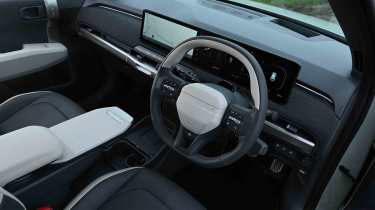
As anyone would reasonably expect from a family-oriented car, the EV3 isn’t designed with white-knuckle driving thrills in mind. Instead what it does do very well is cruise along comfortably, providing ample power for overtaking and getting up to motorway speeds. Of course, gentler driving will help towards maximising efficiency, and the EV3 can cover up to 372 miles on the WLTP combined cycle.
“Kia’s purpose-built electric cars are named in multiples of three, but it doesn’t mean that the Kia EV3 is one third the car the flagship EV9 is. While it doesn’t get the 800-volt architecture of the big seven-seat SUV, it doesn’t skimp on battery capacity or in-car tech.” - Alex Ingram, chief reviewer, who drove the EV3 in the UK.
The flow of fully-electric small SUVs shows no sign of slowing down, so the EV3 faces plenty of competitors. As well as its own Kia Niro EV and Hyundai Kona Electric stablemates, there are also models like the Jeep Avenger, Volvo EX30 and Ford Puma Gen-E that are fighting for their piece of this lucrative market
3. MG ZS

- Prices from £19,995
Pros |
Cons |
|
|
The MG ZS has a much lower starting price than almost all of the competition, but the compromises are quite difficult to find.
Starting from less than £20,000, the ZS’s most direct rival is the Dacia Duster, but the MG is a bit less distinctive to look at than the chunky Romanian off-roader. If you’re not too fussed about standing out, though, MG’s compact SUV holds up well as a family car.
Taller passengers can get nice and comfortable in the back seats, largely thanks to a plentiful kneeroom, and the 443-litre boot has a reasonably low load lip which helps to reduce the need for any awkward stretching. If you have a child car seat, there are ISOFIX points in the back, but these are a bit awkwardly placed between the cushions.
Step inside and the ZS generally keeps up with its far more expensive competitors when it comes to perceived quality, not to mention on-board kit. A few smaller details, such as a lack of steering wheel adjustment, do indicate the MG’s more humble positioning, but it’d be a bit unfair to expect absolute perfection at this price point. Opt for the range-topping Trophy trim (a £2,500 option) and this adds in faux-leather seats, a heated steering and rear privacy glass to help things feel a bit posher.
While there’s no electric variant available at the moment, the MG ZS Hybrid+ can officially return more than 55mpg, so running costs will remain very sensible. Despite the brand’s sports car heritage, the ZS’s hybrid powertrain can become a bit unsettled at higher speeds.
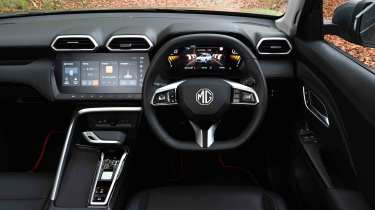
Whenever we needed to get up to motorway speeds quickly during testing, there was a notably long wait for the petrol engine to deliver its best performance. Apart from this, though, this small SUVs does feel deceptively spritely for its size.
“With so much power from its electric motor compared with other hybrids, the MG ZS feels more like an EV around town. From 0-30mph, performance is genuinely excellent.” - Alex Ingram, chief reviewer, who tested the ZS on UK roads.
As we’ve already mentioned, the only competitor which is in the same pricing league as the MG ZS is the Dacia Duster. If you’re tempted by any other similarly-sized rivals, you’ll need to spend more money. However, some of these rivals, such as the Ford Puma, Renault Captur and Peugeot 2008, are still well worth considering
4. Hyundai Kona
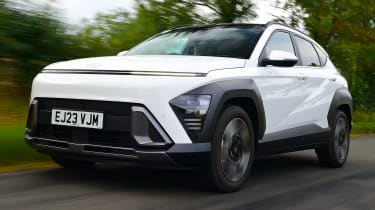
- Prices from £26,735
Pros |
Cons |
|
|
The first-generation Hyundai Kona was already a decent small SUV, but the brand listened very carefully to its customers when designing the current second-generation model.
Along with a massively revamped design that appears to draw inspiration from the brand’s electric Ioniq models, the current Kona also offers much more cabin space — a particularly welcome improvement over the old model. The result is a similar amount of head- and kneeroom to the much larger Hyundai Tucson. The boot is impressive, too, as a 466-litre capacity makes it one of the very biggest in the small SUV class.
As well as being spacious, the interior’s quality has also been improved leaps and bounds. There are top-shelf materials aplenty, while the twin digital displays look bang up-to-date. Our road testers generally look upon Hyundai’s tech in a favourable manner, and the Kona’s 12.3-inch infotainment system is no exception. It’s sensibly laid out, quick to respond and comes with physical shortcut buttons under the screen. Apple CarPlay and Android Auto are thrown in, but you’ll need to bring a cable.
Just like before, the Kona still comes with the choice of petrol, hybrid or fully-electric power. Naturally, the Kona Electric offers the lowest running costs, but no variant should really cause much of a drain on your bank account as even the thirstiest petrol Konas can still achieve over 45mpg. From behind the wheel, all three variants prioritise comfort over performance, although rough surfaces and speed bumps did cause some disturbance during our testing. Things remain composed for the most part, though, particularly at lower speeds. Wind and road noise were minimal.
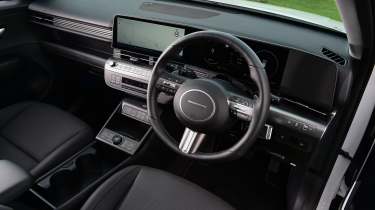
“Admittedly, the daring, sci-fi-inspired styling might not be for everyone, and there are cheaper compact SUVs out there, but right now the Kona looks like extremely good value for such a mature, well equipped and well-rounded car.” - Ellis Hyde, news reporter, who tested the Kona in the UK.
With three very different powertrains on offer, the Hyundai Kona has more than one set of competitors to fight off. The petrol and hybrid models face cars such as the Ford Puma, Peugeot 2008, Jeep Avenger, Skoda Kamiq and Volkswagen T-Roc, while the Kona Electric is up against the likes of the Vauxhall Mokka Electric, Skoda Elroq, Kia EV3 and BYD Atto 3
5. Volvo EX30
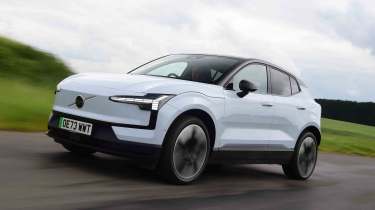
- Prices from £33,060
Pros |
Cons |
|
|
The cheapest electric cars are mostly the smallest, but the Volvo EX30 is a major exception to this rule as it offers a decent helping of both space and luxuriousness for a very tempting price.
While a minimalist interior means there’s no clutter to get in the way, the EX30’s compact stature does mean that passenger legroom is a bit restricted compared to some of the competition. It’s the rear occupants that’ll notice this the most, but if you keep these seats reserved for the young ones, it shouldn’t be too much of a problem. Although the floor is a little high, causing passengers to bunch their knees up, headroom is very good throughout.
The boot isn’t exactly class-leading at 318 litres, but the shape means you easily make use of all of the available space. There’s also an additional 15 litres under the bonnet for the charging cables.
While the general concept of minimalism is a matter of personal taste, we found the EX30’s over-reliance on its touchscreen to be rather frustrating. The vast majority of functions (even adjusting the door mirrors) are controlled via the centre 12.3-inch screen, and many of these are buried in sub-menus. If you’re particularly patient and love your technology, though, the upside is that it’s a pleasant and comfortable interior to sit in, not to mention one that does very well at hiding Volvo’s cost-cutting measures in its small SUV.
Performance fans will be particularly happy as every version of the EX30 will accelerate from 0-62mph in under six seconds. In fact, the Performance model will complete the sprint in a mere 3.6 seconds. The EX30 can cover plenty of miles between charges, too, as even the entry level Single Motor model has a claimed maximum range of 213 miles. Opt for the Long Range variant and this number increases to 293 miles.
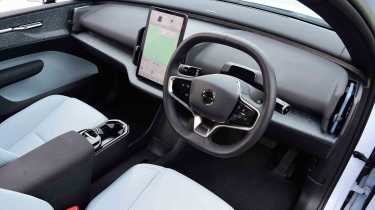
“The EX30 makes a good case for itself with a high list of standard safety features and equipment, plus a premium feel inside beyond its reasonable asking price. It’s also remarkably quick in Twin Motor Performance form.” - Alex Ingram, chief reviewer, who tested the EX30 on UK roads.
As a low-cost electric SUV with a premium badge, the Volvo EX30 is a bit of an unusual offering. Two models which tread a similar line, though, are the Alfa Romeo Junior and DS 3 E-Tense — both of which share the same Stellantis CMP platform
6. Alfa Romeo Junior
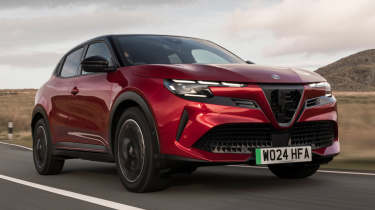
- Prices from £28,100
Pros |
Cons |
|
|
Alfa Romeo SUVs tend to upset a few of the brand’s die-hard fans, but the Junior is a likable car for the masses.
While this Italian sports car purveyor isn’t exactly a byword for sensible cars, the Junior does still cope fairly well with the day-to-day stuff. The boot ranges from 400 litres in the Elettrica EV model up to 415 litres in the Ibrida hybrid, both of which are pretty-much par for the course in this sector of the market, but still plenty for the weekly shop.
Unfortunately, where this Alfa does rekindle memories of sports cars past is in the rear seats, as any passengers who are remotely close to six-feet tall will quickly notice an absence of legroom. Children should manage just fine, though they may become a bit bored as there are absolutely no features to be found in the back, not even cup-holders.
Mercifully, Alfa hasn’t forgotten to adorn the area surrounding the front seats with various bits of kit. In fact, it’s here where the Junior starts to shine as it manages to feel very distinctive and sporty, even though it sits on Stellantis’s widely-used CMP platform. There’s a red-and-black colour scheme throughout, the dashboard is angled towards the driver and the round air vents feature subtly illuminated logos. Elsewhere you’ll find the typical Stellantis touches, but all the controls and infotainment system are easy enough to figure out.
Naturally, being an Alfa, the Junior is pretty enjoyable from behind the wheel, although the trade-off is a rather firm ride. Those who really want to get a move on will be best served by the 27bhp Junior Veloce, but all versions will accelerate from 0-62mph in less than nine seconds.
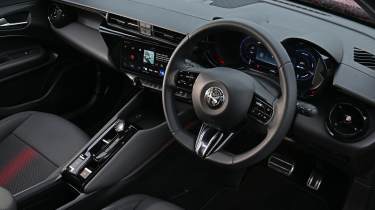
The steering is well weighted and it felt very precise to use during testing. With all versions offering 200-plus miles of range on the WLTP combined cycle, the Junior should prove pretty easy to live with on a daily basis.
“The Alfa Romeo Junior is by far and away our favourite of the Stellantis collection of small SUVs based on the CMP platform.” - Alex Ingram, chief reviewer, who tested the Junior on British roads.
There’s no shortage of cars that share the same platform as the Alfa Romeo Junior, so there’s plenty of competition for it to face from within the Stellantis stable. These include The Peugeot E-2008, Vauxhall Grandland Electric, Jeep Avenger and Fiat 600e. For those who want something sporty and Italian in a different flavour, there’s also the Abarth 600e
7. Jeep Avenger
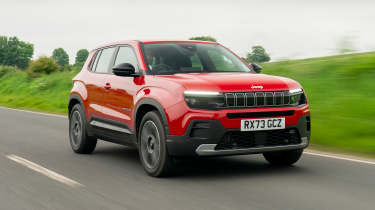
- Prices from £25,219
Pros |
Cons |
|
|
The Jeep Avenger is compact in size and two-wheel drive, but it still manages to live up to its badge.
Even though this Jeep is quite small, even by small SUV standards, it still feels roomy inside. Carrying taller passengers in the front will restrict who can travel in the back but for two adults and two children, there’s ample room.
If taller rear passengers do need to squeeze into the rear, the backs of the front seats are soft, so at least there won’t be any banged knees. Those who need to carry a child seat can find ISOFIX points in both the front and rear, but the Avenger’s small door openings can make the fitting process a bit tricky.
Jeeps are associated with toughness, and the Avenger’s interior follows this ethos very closely. There’s square edges, chunky shapes and durable plastic everywhere, and it’s all put together in a very robust way.
An abundance of proper buttons is a welcome sight, too, it’s all too obvious that this is not a luxurious vehicle. If you’re not bothered by the lack of plushness, though, you can spend hours trying to discover all of the Avenger’s ‘Easter eggs’, such as the seven-slot Jeep grille motifs located throughout the car.
Perhaps most importantly to any prospective Jeep owners, the Avenger does offer a modicum of off-road ability, even though it’s exclusively a front-wheel drive car. You can choose between Mud, Sand and Snow drive modes, and a hill descent system is also fitted as standard.
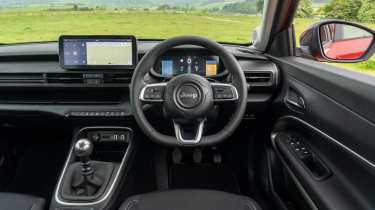
The Avenger is competent at dealing with slippery and rough terrain, but it’s still important to remember that it’s not exactly a Wrangler. If you’re sticking with the tarmac, the Avenger is very easy to manoeuvre through tight streets thanks to its small size and great visibility. It’ll take a while to get up to motorway speeds, but once you get there the little Jeep is pretty comfortable and peaceful on long trips.
“Whether you choose the Jeep Avenger in petrol or all-electric forms, you’ll get an enticing small SUV with hidden depths beyond its attractive exterior.” - Ellis Hyde, news reporter, who tested the Avenger in the UK.
Jeep is part of the Stellantis group so its baby SUV shares DNA with plenty of other models from the likes of Peugeot, Vauxhall and Citroen. With prices starting from around £30,000 for the fully-electric Avenger, EV buyers also have the Vauxhall Frontera, MGS5 EV and Mazda MX-30 to take into consideration
8. Renault Captur
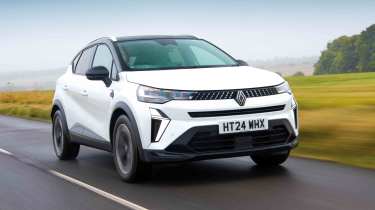
Prices from £22,195
Pros |
Cons |
|
|
As a two-time Auto Express small SUV of the Year award winner, the Renault Captur is still a sensible option with plenty of added style.
Despite its compact dimensions, the stylish Captur serves up a surprising amount of space inside, while its sliding rear bench adds an extra dose of practicality. Renault’s smallest SUV sits on the same underpinnings as the Clio Supermini, but the latest model is slightly larger than the car it replaced. This extra height, width and length has been put to good use within the cabin, while a number of useful storage features also go towards making this a tempting candidate for small families.
To accompany its striking exterior, the Captur’s interior also packs a level of visual appeal. A slick design, plenty of high-grade materials and an eye-catching portrait-style infotainment set-up all make this feel like a much pricier car than it actually is. We’re big fans of Renault’s Google-based infotainment tech, too, as it looks great and is very straightforward to use with only a little bit of practice.
It’s not as sharp to drive as some rivals, but the Captur’s supple suspension and strong refinement mean that it’s very comfortable and relaxing. There’s the choice of petrol or hybrid power, and while the latter tech is more expensive to buy, it can officially return over 60mpg. If you’re a new driver, there’s more good news as the Captur is fairly cheap to insure, starting from as low as group 11.
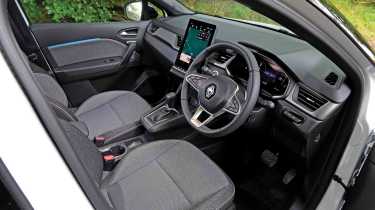
“It’s not as sharp to drive as some rivals, but fundamentally the Captur’s focus on what its buyers will appreciate is enough to keep it at the sharp end of the class.” - Alex Ingram, chief reviewer, who road tested the Captur in the UK.
For those who want a stylish small SUV from across the channel, the obvious alternative to the Captur is the Peugeot 2008. Beauty is in the eye of the beholder, though, and there are plenty of other attractive alternatives from elsewhere around the globe. The SEAT Arona, Volkswagen T-Cross, Toyota Yaris Cross, Ford Puma and Jeep Avenger are just some of the many SUVs to choose from, depending on your personal tastes
9. Kia Niro
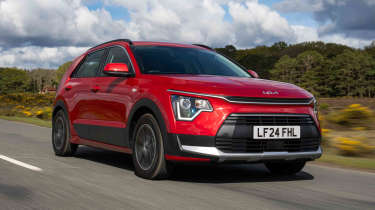
- Prices from £30,270
Pros |
Cons |
|
|
The Kia Niro is a bit understated compared to the Korean brand’s more recent arrivals, but it still gets the fundamentals spot on.
Bearing in mind that the Kia Niro has been designed to accommodate either a hybrid, plug-in hybrid or fully-electric powertrain, no obvious sacrifices have been made in terms of passenger or cargo space. While the previous Niro was already a commodious car, the latest model can accommodate five people with even more room to spare. An abundance of headroom and large windows help to make the Niro feel bright and airy inside, too.
Boot space does vary depending on your chosen powertrain, but the best load-lugger is the Niro EV with 475 litres at its disposal. We found loading heavier items to be a bit difficult at times, though, due to the rather high load lip.
The Niro’s simple design continues inside, but it’d be unfair to describe it as boring. Everything is logically laid out, and the twin-screen dashboard is clear and easy to understand. Quality-wise everything feels robust enough for family use, but the sight of piano black plastic will quickly instill a fear of fingerprints and scratches. If your loved ones enjoy their gadgets, there’s a number of USB charging points to be found throughout the cabin.
As its appearance suggests, the Niro doesn't offer much in the way of entertainment from behind the wheel, but it is a perfectly calm and competent car to drive. Wind and tyre noise are minimal at motorway speeds, and the power and brakes are easy to modulate for a smooth experience.
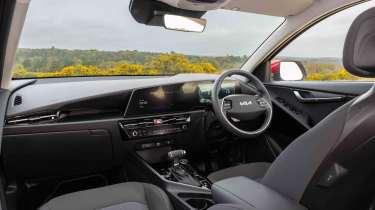
It’s the all-electric Niro EV that’s the certified star of the line-up, and its large 64kWh battery has an impressive claimed range of 285 miles. The EV also packs eager acceleration, but the added weight of the batteries makes the suspension a bit more susceptible to bumps in the road.
“Cabin space across the Niro range is superb, its infotainment system is top-notch, and the low running costs are particularly appealing, but just like the old car, the Niro doesn’t feel all that special to drive.” - Ellis Hyde, news reporter, who tested the Niro in the UK.
Few other small SUVs come with the choice of hybrid, plug-in hybrid or fully-electric power, but one of the few that does is the closely-related Hyundai Kona. In fact, this previous Auto Express New Car Awards winner manages to undercut the Niro on price, hence the Kia finds itself further down this list than its sibling
10. Ford Puma
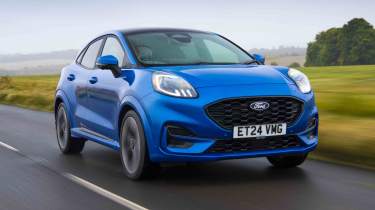
- Prices from £26,580
Pros |
Cons |
|
|
The Ford Puma is one of the best-selling cars in the UK, and it’s not very hard to see why.
Now that the Fiesta supermini is no longer with us (at least for the time being), the Ford Puma has taken on the role of being the brand’s small, affordable car that’s also practical and genuinely fun to drive. Whichever version you choose, the Puma’s interior is relatively roomy and well equipped. The 456-litre boot is very generous if not quite class-leading, and lurking under the boot floor is Ford’s surprisingly useful 80-litre ‘Megabox’.
Although the Puma’s cabin doesn’t feel as upmarket as those of some rivals’, a mid-life facelift has seen things take a step in the right direction. General fit-and-finish feels a lot more polished, and there’s no missing the new 12-inch SYNC infotainment system, which takes up a significant portion of the dashboard. We just wish that the updated tech was a bit more intuitive and quicker to load.
Fast steering and impressive agility make Ford’s baby SUV a real treat to drive. No version of the Puma (not even the revised ST) feels massively quick, but its compact size and Fiesta underpinnings mean you can successfully throw it around B-roads in a very enjoyable manner.
If you’re considering making the switch to an electric car, the Ford Puma Gen-E has now been added to the line-up. This claims up to 234 miles of range on a single charge, but it costs around £3,500 more than the equivalent petrol model.
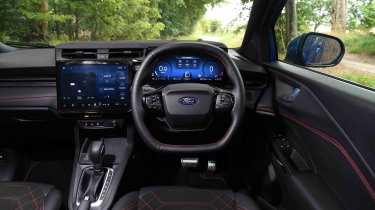
“Ford has earned a reputation for producing a range of everyday cars that appeal to the keen driver after decades of sharp-handling hatchbacks. The Puma lives up to that.” - Alex Ingram, chief reviewer, who tested the Puma in the UK.
The Puma is currently one of the very best small SUVs to drive, so it'll be difficult to find an alternative without sacrificing at least some of the fun factor. If budget isn’t too much of a concern, the BMW X1 is another small SUV that caters for driving enthusiasts.
How to choose the best small SUV
If you’re in the market for a small SUV you are not short of choice but there are some important things to consider when doing your research and taking your test drives to help assemble that shortlist.
Size
While all of these cars are officially described as small SUVs, there can still be some size differences between models. If you’re looking for a family car, you’ll want to pay close attention to figures such as the boot and cabin space. Clever interior storage cubbies can also prove highly useful.
Fuel
We live in a time where there’s plenty of choice when it comes to powering your new small SUV. Whether you want to stick with traditional petrol or switch over to a hybrid (plug-in or otherwise), there are plenty of options available. Of course, you could take this opportunity to switch over to a fully electric car, with more and more zero-emission small SUVs making their debut.
Price
Everybody loves a bargain, and several small SUVs boast very tempting starting prices thanks to their supermini origins. As with any car, it’s important to know who you’d like to pay for your new SUV well in advance. There are plenty of Personal Contract Purchase (PCP) deals up for grabs, or perhaps a Personal Contract Hire (PCH) leasing deal would be better suited to your needs. Whatever the case, be sure to shop around once you’ve chosen your ideal financing method.
More SUVs to choose from
We’ve rounded up the best small SUVs, but perhaps you’d care for something a bit bigger? If so, our best mid-size SUVs page takes a look at cars from the class above. Alternatively, you could go for a full-sized option by taking a look at the best large SUVs.
Say goodbye to those emissions! These are the best electric SUVs…

